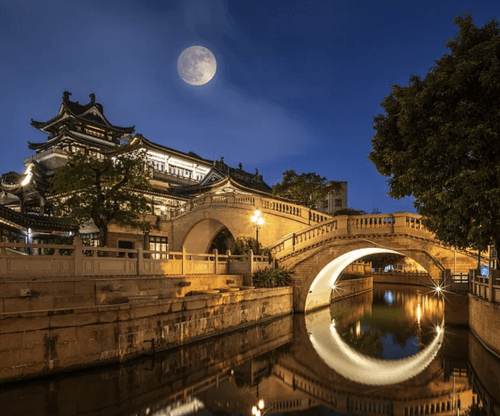
Xiguan (Liwan) Stepping Through Guangzhou's Time Portal
My name is Liam, a travel blogger focused on discovering places where I can truly smell the history. My journey brought me to Guangzhou, China, where I found a place that forced me to slow down and fully immerse myself: Xiguan (literally, "West Gate"), located in the city's historical Liwan District.
Xiguan is not just a tourist attraction; it’s a living, breathing old neighborhood. Walking here feels like opening an antique family album—every page radiates a warm, genuine sense of life and local charm. If you want to find the true spirit of the "Lao Guang" (Old Guangzhou locals), this is exactly where you need to be.
I want to share my personal experience, guiding you through Xiguan's unique allure from four perspectives: its historical context, architectural soul, cultural depth, and, of course, its unforgettable cuisine.
I. Time Travel: The Historical Canvas of Xiguan
Xiguan is named for its location just outside the old city wall's west gate. The area flourished significantly during the Qing Dynasty, thanks to Guangzhou's role as the single port for foreign trade—the Canton System.
Prosperity and the Clash of Worlds
From the 18th to the 19th centuries, vast quantities of silk, tea, and porcelain were exported to the world from here, drawing immense wealth into the area. Rich merchants, Compradors (local agents for foreign traders), and prominent families all built their elaborate residences in Xiguan.
Situated right next to the Pearl River, Xiguan is crisscrossed by waterways, such as the historical Litchi Bay Creek (Lizhiwan Chong). This gave the area not only a commercial center but also the gentle, poetic scenery of a waterside town. This blend of commercial prosperity and waterside elegance is key to Xiguan’s unique charm.
The Refinement of the "Xiguan Miss"
An old Guangzhou saying goes: “Dongshan Young Masters, Xiguan Misses.”
The Dongshan Young Masters were typically the sons of officials and military elites living in the city’s east, representing power and new trends.
The Xiguan Misses were the daughters of the wealthy merchant families living in the grand Xiguan houses—educated, well-mannered, and representing the most exquisite, sophisticated urban culture and lifestyle of Guangzhou.
Xiguan’s history is a compelling story of global trade, accumulated wealth, refined living, and the initial encounter between Chinese and Western cultures.
II. The Architectural Soul: Wisdom in Doors and Windows
The most iconic features of Xiguan architecture are the traditional Xiguan Grand Houses (Xiguan Daya) and the distinctive street-side Qilou (Arcade Houses). They are masterpieces of Lingnan (Guangdong) architecture, perfectly embodying the local philosophy of seeking both private tranquility and airy ventilation.
The Xiguan Grand House: Three Doors, One Genius Design
I was fascinated by the unique Three Doors (San Jian Tou) system of the Xiguan Grand Houses—a brilliant solution to security and climate control.
Door One: The Dwarf Gate (Ai Jiao Men): This door is short and partially open, allowing air to circulate while maintaining privacy.
Door Two: The Sliding Grille Door (Tang Long Men): This is the most special part. It's a wooden lattice gate on a sliding track (Tang means slide, Long means grille). During hot days, only this gate would be closed. It acts as an effective security screen and a filter for cool breezes, keeping thieves out while letting air through—an ideal piece of passive climate technology.
Door Three: The Solid Main Door (Ying Mu Da Men): The inner, thick hardwood door provides strong security at night.
The Manchurian Window: Romantic Fusion
Another signature of these houses is the Manchurian Window (Manzhou Chuang).
These are wooden frames set with etched, multi-colored glass panes. The glass, often imported or made using Western techniques, features delicate Chinese motifs like birds, flowers, and landscapes.
When the sun streams through the blue, green, yellow, and red glass, it casts magical colored light and shadow across the room. It’s incredibly romantic and served a practical purpose: softening the light and reducing heat penetration. These windows are a testament to the cultural fusion facilitated by Guangzhou's trading past.
The Qilou (Arcade Houses): Shelter for Life
Walking along commercial streets like Enning Road or Shangxiajiu, you'll see lines of Qilou—buildings where the upper floors project out over the sidewalk, supported by columns.
Its Function: In the humid, rainy, and hot subtropical climate of Guangzhou, the Qilou’s lower arcade provides a continuous, dry, and shady walkway for pedestrians.
Its Cultural Significance: This design reflects the Cantonese people’s pragmatism and commercial flair. The ground floor is for business, and the upper floors for residence. The covered walkway ensures that commerce can thrive "rain or shine," making the Qilou the very symbol of Guangzhou's "Thousand-Year Commercial City" spirit.
IV. The Cultural Canvas: Cantonese Opera and Water Town Rhythms
Xiguan is not only about architecture; it holds the deep cultural soul of the Cantonese people. Here, culture is palpable—you. You can hear it, see it, and feel it flow.
Enning Road and Yongqing Fang: A Living Heritage
If you want to feel this cultural pulse, head to Enning Road and the beautifully revitalized area of Yongqing Fang.
The Home of Cantonese Opera: This area is often called the "Homeland of Cantonese Opera (Yueju)." It was historically a gathering place for opera troupes and artists. The ancestral home of martial arts legend Bruce Lee (Li Xiaolong) is also located within Yongqing Fang, connecting this local heritage to global fame.
The Museum and the Stage: Nearby, the Cantonese Opera Art Museum (Guangdong Yueju Art Museum) sits beside the Litchi Bay Creek. Its traditional garden setting features a classical stage where local enthusiasts and professionals still perform, ensuring this ancient art form continues to resonate.
The Moon Bridge (Yueliang Qiao): In Yongqing Fang, a modern landmark has become a favorite: the Moon Bridge. At night, when the bridge lights up, its perfect arch reflects on the water, creating a complete circle—a stunning "full moon" effect. It’s a lovely blend of contemporary design and the serene water town aesthetic.
Liwan Lake: Tranquility and Tradition
Just north of Enning Road lies the peaceful Liwan Lake Park.
The Lakeside Stage: By the lake, you'll often find a traditional-style opera pavilion or teahouse. Elderly locals gather here, sipping tea and chatting, while opera lovers spontaneously take to the stage to sing Yuequ (Cantonese music/opera excerpts). This melodious, lingering sound provides the most authentic soundtrack to the lake scenery.
The Dragons Beneath the Water: The area around Liwan Lake (Pan Tang) is a birthplace of the region's vibrant Dragon Boat culture. When the Dragon Boat racing season is over, the wooden boats are not stored in a shed; instead, they are ceremonially sunk into the muddy lake bottom for preservation—a tradition known as "Cang Long" (Hiding the Dragon). This ancient ritual shows the community's deep respect for these vessels, which are symbols of clan unity and a prayer for good weather and harvest.
In Xiguan, culture is not locked away in a cabinet; it’s the lake water, the melody, and every conversation on the street.
V. The Palate of Xiguan: Eat in Guangzhou, Flavor in Liwan
They say, "Eat in Guangzhou (Shi Zai Guangzhou)," but locals will tell you, "The Flavor is in Liwan (Wei Zai Liwan)." Xiguan is the birthplace and gathering point of authentic Cantonese cuisine, offering food that is warm, delicate, and deeply comforting.
The Must-Try "Four Famous Snacks"
Boat Congee (Ting Zai Zhou): The congee base is slow-cooked until incredibly smooth, and it’s loaded with ingredients like fish slices, fried peanuts, and shredded egg—a complex texture and flavor experience.
Steamed Rice Noodle Rolls (Bu La Chang Fen): The thin rice noodle sheet is pulled out using a cloth steamer, then wrapped around shrimp or beef, and dressed with a special soy sauce. It must be "thin, slippery, and smooth."
Wonton Noodles (Yun Tun Mian): Look for "Bamboo-Pushed Noodles" for the best texture. The noodles are springy, the shrimp wontons are plump, and the broth is simmered with dried fish and shrimp—the ultimate Cantonese comfort food.
Double-Skin Milk Pudding (Shuang Pi Nai): A must-have dessert! Made with buffalo milk, it sets into two layers of smooth milk skin. The texture is delicate and silky, the milk flavor is rich, and the sweetness is perfectly balanced.
Authentic Tasting: Finding the Soul Food
Chen Tian Ji (祖传爽鱼皮): Try their "Ancestral Crispy Fish Skin," served cold and dressed with ginger and soy sauce. The crunchy texture is addictive and a true local delicacy.
Morning Tea (Yum Cha): Visit heritage teahouses like Tao Tao Ju or Lian Xiang Lou for an authentic dim sum experience. Order the classic Ha Gao (shrimp dumplings) or Su Pi Pineapple Buns (crispy crust buns). Savor the pace of "One Cup, Two Pieces" (Yi Zhong Liang Jian)—tea and two dim sum dishes—the timeless ritual of the Lao Guang.
Xiguan's food is not fast food; it's a social ritual and a reflection of a meticulous approach to daily life.
My Xiguan Diary: Slow Down to See
My Xiguan journey began at the Changshou Lu Metro Station and led me straight into Enning Road and Yongqing Fang.
I consciously refused to rush. I spent an entire morning just observing the old houses.
I saw the silhouettes of old mansions through the gaps of the wooden Sliding Grille Doors, imagining the "Xiguan Miss" waiting inside a century ago. I loved the lighting effect from the Manchurian Windows; in a preserved grand house in Yongqing Fang, the sunlight projected colored shapes onto the wooden floor—a tranquil romance that no modern screen can replicate.
At lunchtime, I settled into a small noodle shop for Boat Congee and a plate of Rice Noodle Rolls. I watched the owner skillfully pull the translucent sheets from the steamer, a quick, expert move honed over decades. Holding that warm bowl of congee, I felt the temperature of the food was the same temperature as the Lao Guang’s passion for life.
In the late afternoon, I sat by Liwan Lake, sipping tea, listening to the faint, lingering sound of Cantonese Opera drifting over the water. The lake, the breeze, the distant music—it all confirmed that I wasn't just in a tourist spot; I was in a place with a profound soul.
My takeaway from Xiguan is this: it's not a perfectly planned tourist destination; it's an art of living perfected over centuries. It's genuine, sophisticated, and deeply rooted in its love for life. If you want to experience a Chinese city with both historical depth and everyday authenticity, put Xiguan (Liwan) at the top of your list.
Come here, slow down, and you will truly smell the flavor of Old Guangzhou.


